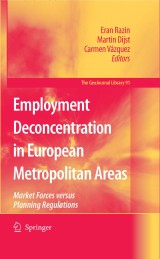Details

Employment Deconcentration in European Metropolitan Areas
Market Forces versus Planning RegulationsGeoJournal Library, Band 91
|
149,79 € |
|
| Verlag: | Springer |
| Format: | |
| Veröffentl.: | 06.09.2007 |
| ISBN/EAN: | 9781402057625 |
| Sprache: | englisch |
| Anzahl Seiten: | 304 |
Dieses eBook enthält ein Wasserzeichen.
Beschreibungen
European metropolitan areas have experienced a marked reorganization associated with the processes of globalization and the European integration of economic act- ities on various spatial scales. Much of this change is particularly evident at the edge of central cities, further away at suburban locations and on the fringes of expanding metropolitan areas. These spatial processes of urban expansion, sprawling dev- opment, and employment deconcentration present constant challenges to urban quality of life, raising concerns about excessive consumption of land and energy, traffic congestion, and so forth. These concerns prompt the formulation of public policies at various levels of government: European Union agencies, national, and sub national public authorities. The challenges posed by the spatial reorganization of economic activities within European metropolitan areas and their implications for the quality of life inspired the research project sponsored by the European Commission 5th Framework, entitled: Spatial Deconcentration of Economic Land Use and Quality of Life in European Metropolitan Areas (SELMA). The primary goal of SELMA was to design urban planning and management strategies to ensure the maintenance of the quality of life in European metropolitan areas. To this end, three broad activities were defined. The first focused on the identification and analysis of the driving forces and dynamics behind the process of economic land-use deconcentration in metropolitan areas. An analysis of the impacts of these processes on urban quality of life formed the heart of the second activity.
Introduction: Deconcentration of economic activities within metropolitan regions: A qualitative framework for cross-national comparison.- Economic deconcentration in a rational planning system: The Dutch case.- Deconcentration of workplaces in greater Copenhagen: Successes and failures of location strategies in regional planning.- Economic deconcentration processes in mid-sized English cities: Deconcentrated outcomes and spatially differentiated impacts.- The Spanish way to economic deconcentration: A process of several speeds.- The Italian way to deconcentration. Rome: The appeal of the historic centre. Chieti-Pescara: The strength of the periphery.- Deconcentration in a context of population growth and ideological change: The Tel-Aviv and Beer-Sheva metropolitan areas.- Sprawling post-communist metropolis: Commercial and residential suburbanization in Prague and Brno, the Czech Republic.- The impact of retail deconcentration on travel to hypermarkets in Prague.- Employment deconcentration in European metropolitan areas: A comprehensive comparison and policy implications.
<P>Spatial deconcentration of economic activities, particularly the growth of suburban office, retail and entertainment concentrations, has become a prime concern in European metropolitan areas. This book provides a cross-national comparative perspective on employment deconcentration within selected metropolitan areas in Europe. Whereas most debate over urban sprawl and deconcentration is oriented towards the North American context, this book aims at a better understanding of this phenomenon in the European context, emphasizing the location of economic activities rather than residential patterns. It provides insights on whether different governance attributes produce particular forms of deconcentration versus the influence of market attributes and local specificities, also commenting on quality of life impacts and possible governance and policy implications of the deconcentration process. </P>
<P>Introduction of a comparative framework is followed by eight case study chapters, three representing northern Europe, three the southern European-Mediterranean region and two post-communist central Europe. Most chapters examine two metropolitan areas, usually a large one and a smaller one. The comparison reveals considerable variations in the magnitude, form, and process of employment deconcentration, only partly in line with expected influences of governance systems. Evidence does not fully confirm an anticipated distinction between Northern and Mediterranean Europe; the Czech Republic and Israel seem to diverge most from prevailing European trends.</P>
<P>Introduction of a comparative framework is followed by eight case study chapters, three representing northern Europe, three the southern European-Mediterranean region and two post-communist central Europe. Most chapters examine two metropolitan areas, usually a large one and a smaller one. The comparison reveals considerable variations in the magnitude, form, and process of employment deconcentration, only partly in line with expected influences of governance systems. Evidence does not fully confirm an anticipated distinction between Northern and Mediterranean Europe; the Czech Republic and Israel seem to diverge most from prevailing European trends.</P>
Adds a unique feature to the voluminous literature on urban sprawl: the focus on economic activities Focus on European metropolitan areas (and on economic activities within European metropolitan areas) Unique comparative perspective on employment deconcentration that includes also transformed post-communist and Israeli metropolitan areas Contribution to the literature on urban outcomes of transformed welfare state regimes Detailed accounts on spatial processes in selected major European metropolitan areas
Diese Produkte könnten Sie auch interessieren:

Observing Systems for Atmospheric Composition

von: Guido Visconti, Pietro Di Carlo, W. Brune, M. Schoeberl, Andreas Wahner

149,79 €















